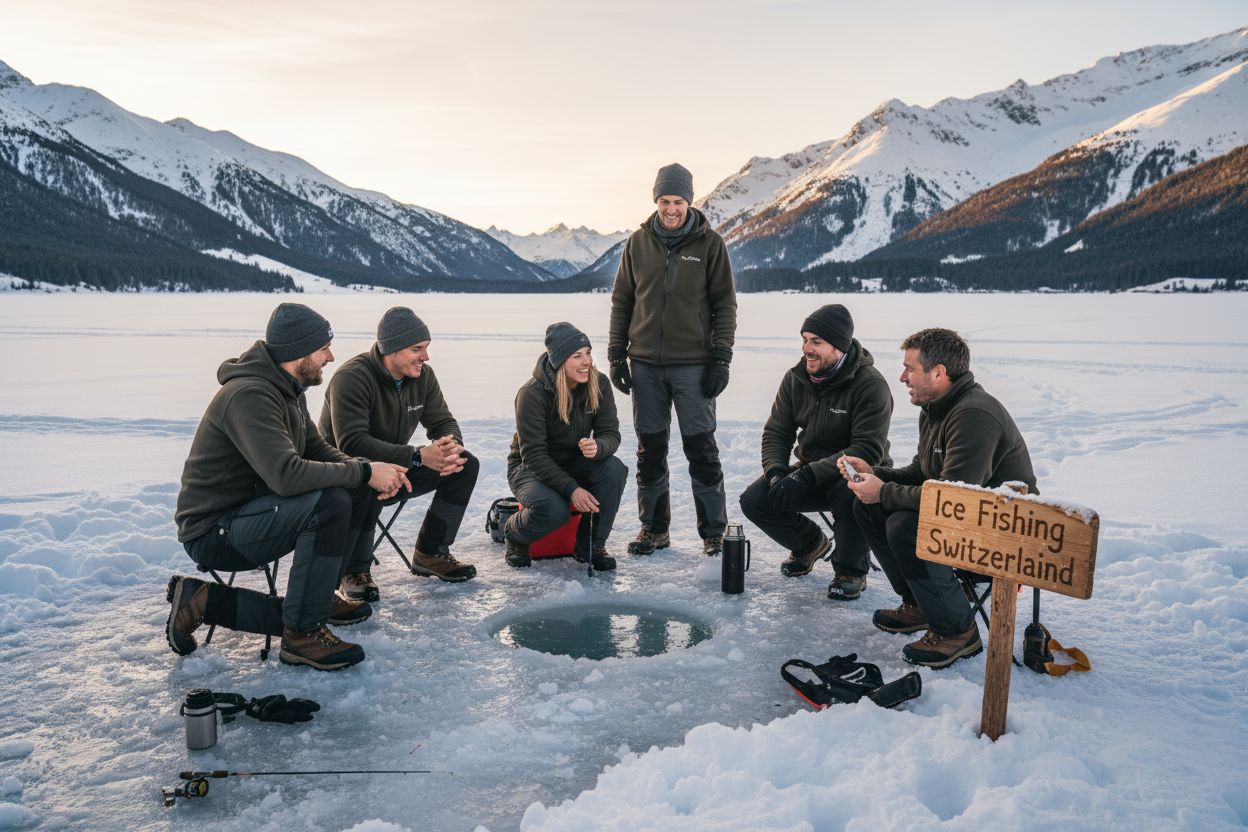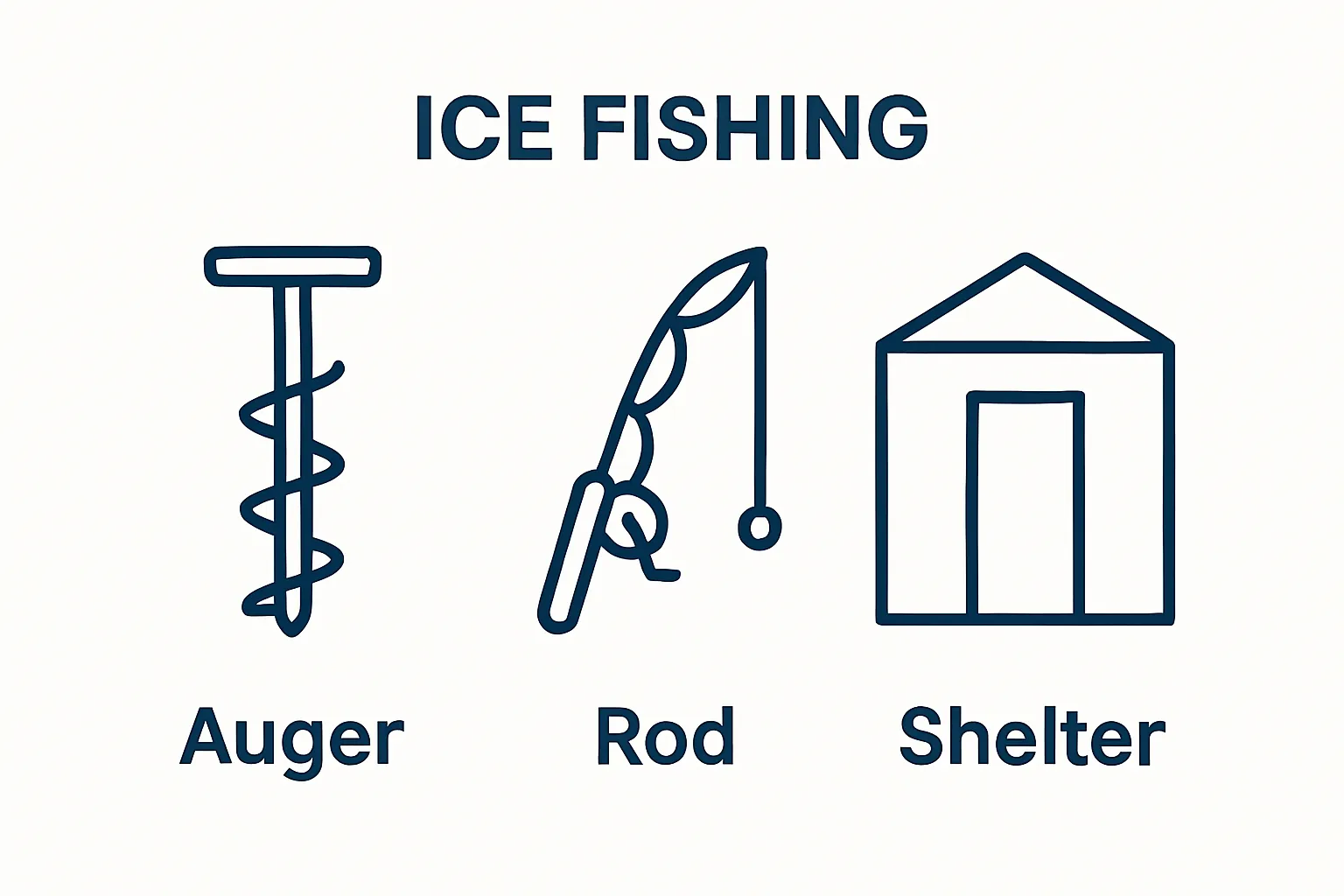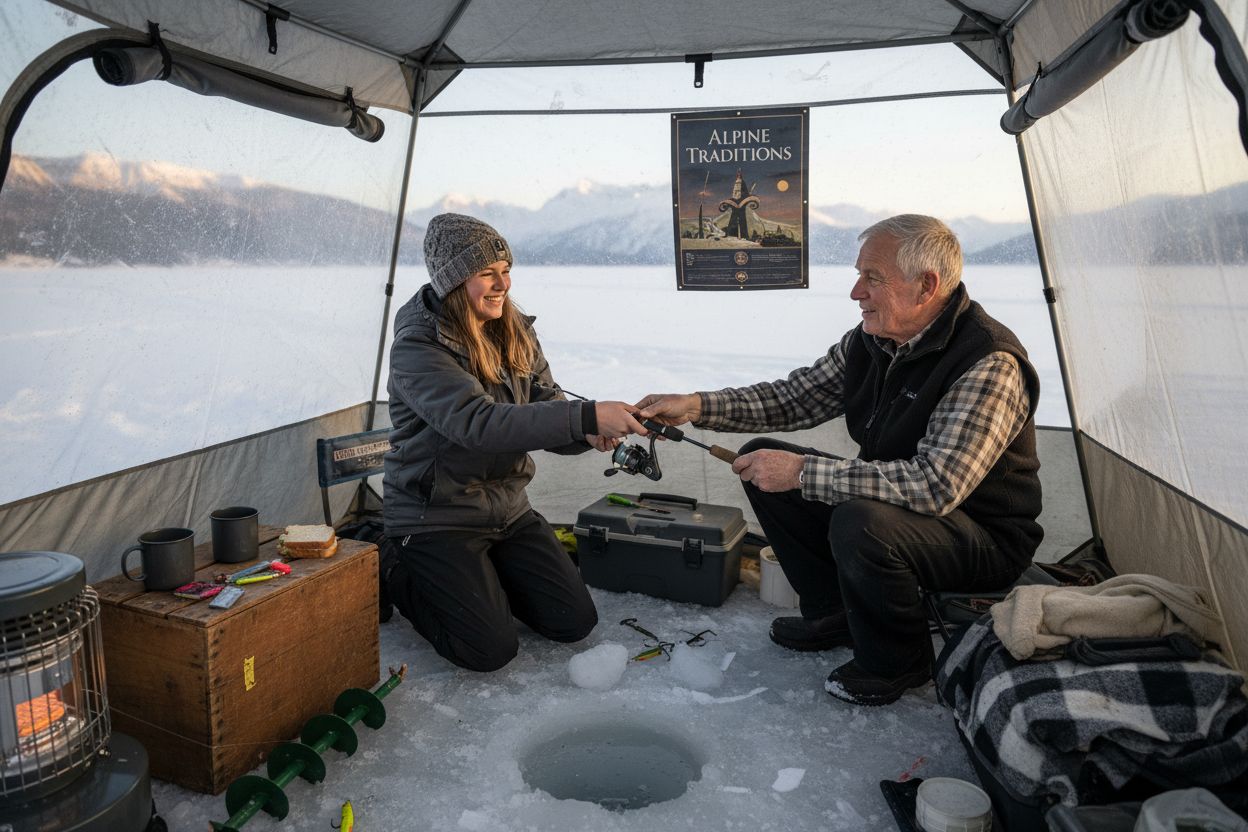Understanding Ice Fishing in Switzerland: A Deep Dive
- info1419758
- Oct 6
- 8 min read

Ice fishing in Switzerland might sound like a quiet pastime for winter weekends, but the tradition runs much deeper than just dropping a line through a frozen lake. Lakes in areas like the Engadine Valley freeze solid, setting the stage for a centuries-old practice where entire communities gather and share survival skills. Most people picture Swiss winters as all skis and hot chocolate, yet ice fishing reveals a culture built on resilience and a keen respect for nature. The real surprise comes from its cultural roots and ecological impact, which are anything but cold and silent.
Table of Contents
Quick Summary
Takeaway | Explanation |
Ice fishing is a cultural tradition. | This practice reflects the rich heritage and survival strategies of alpine communities in Switzerland. |
Proper equipment is essential for safety. | Using specialized gear like insulated shelters and augers ensures a safe and effective ice fishing experience. |
Ice fishing supports local economies. | Though not a primary source of income, it contributes to tourism and local businesses in alpine regions. |
Sustainable practices are crucial. | Anglers must adhere to ecological guidelines, ensuring minimal impact on fragile alpine ecosystems during fishing. |
Communal knowledge enhances skills. | Ice fishing serves as a platform for intergenerational knowledge transfer, fostering community ties and cultural preservation. |
What is Ice Fishing and Its Origins in Switzerland?
Ice fishing in Switzerland represents a unique winter tradition deeply rooted in alpine communities, transforming frozen lakes into seasonal fishing grounds. Unlike typical recreational activities, this practice combines survival skills, cultural heritage, and a profound connection with alpine environments.
The Traditional Swiss Ice Fishing Landscape
Switzerland offers remarkable conditions for ice fishing, particularly in high-altitude regions where lakes freeze solid during winter months. Research from Swiss Alpine Fisheries indicates that lakes in areas like the Engadine Valley provide ideal settings for this specialized winter activity.
Key characteristics of Swiss ice fishing include:
Precise understanding of ice thickness and safety protocols
Specialized equipment designed for alpine conditions
Deep respect for local ecological regulations
Cultural and Practical Dimensions
Traditionally, ice fishing in Switzerland was not merely a recreational pursuit but a critical food procurement method for mountain communities. Fishers would carefully select locations where lake trout, Arctic char, and whitefish were abundant. Modern practitioners blend traditional techniques with contemporary conservation approaches.
For those interested in exploring more winter activities in the Swiss landscape, check out our guide on winter adventures in Switzerland, which offers additional insights into alpine recreational opportunities.
The process requires significant skill: cutting precise holes through ice layers, understanding fish behavior during cold months, and using specialized equipment like insulated shelters, ice augers, and sensitive fishing gear.
To clarify the essential gear and its specific functions in Swiss ice fishing, here is a breakdown of key equipment and purposes:
Equipment | Purpose |
Hand auger | Cuts precise fishing holes in thick lake ice |
Insulated shelter | Provides protection from extreme alpine cold |
Ice fishing rod (sensitive tip) | Detects subtle fish bites in cold conditions |
Thermal clothing | Maintains body heat in harsh winter environments |
Portable heater | Offers warmth during long fishing sessions |
Safety traction gear | Helps prevent slips and ensure stable footing |
Ice thickness measurement tool | Verifies safe ice conditions before fishing |
The Importance of Ice Fishing in Swiss Culture and Economy
Ice fishing in Switzerland transcends a mere winter recreational activity, representing a nuanced intersection of cultural preservation, local economic sustenance, and ecological interaction. This practice embodies more than just catching fish it symbolizes community resilience and alpine adaptability.
Cultural Preservation and Social Dynamics
Research from Swiss Alpine Studies reveals that ice fishing serves as a critical social mechanism in mountain communities. It functions as a communal gathering point where generations exchange knowledge, share experiences, and maintain traditional skills passed down through centuries.
Key cultural significance includes:
Intergenerational knowledge transfer
Preservation of traditional alpine survival techniques
Maintaining social connections during winter isolation
Economic Implications for Alpine Regions
While not a primary commercial enterprise, ice fishing contributes meaningfully to local economies. Small alpine communities leverage this activity through associated tourism, equipment sales, and specialized winter services. Local businesses benefit from gear rentals, guided experiences, and supporting infrastructure for winter anglers.
For enthusiasts interested in exploring more alpine economic activities, discover unique outdoor adventures in Switzerland that showcase the diverse economic potential of seasonal pursuits.
Ecological Interaction and Conservation
Modern Swiss ice fishing practices emphasize sustainable interaction with natural environments. Anglers must obtain specific permits, adhere to strict catch limits, and participate in broader ecological monitoring programs. This approach transforms ice fishing from a mere recreational activity into a collaborative conservation effort, where practitioners become active stewards of alpine aquatic ecosystems.
How Ice Fishing Works: Techniques and Equipment Overview
Ice fishing in Switzerland demands specialized knowledge, precision equipment, and a profound understanding of alpine winter environments. This technical discipline combines advanced preparation, strategic location selection, and meticulous safety protocols.
Essential Equipment and Preparation
Swiss Fishing Regulations highlight the importance of specialized gear designed for extreme alpine conditions. Critical equipment includes:

Hand augers for creating precise fishing holes
Insulated shelters protecting against extreme temperatures
Specialized ice fishing rods with sensitive tip mechanisms
Thermal clothing and safety traction gear
Compact portable heaters for extended fishing sessions
Technical Approaches and Fishing Strategies
Successful Swiss ice fishing requires understanding lake topography, fish behavior during winter, and precise hole positioning. Anglers typically employ active and passive fishing techniques, selecting locations where underwater currents and temperature gradients suggest higher fish concentrations.
For adventurers seeking comprehensive winter activity insights, explore our guide to outdoor adventures in Switzerland that provides additional context about alpine winter experiences.
Safety and Environmental Considerations
Safety represents the paramount concern in Swiss ice fishing. Strict protocols mandate comprehensive ice thickness assessments, typically requiring a minimum of 4 inches of solid ice for safe fishing. Experienced anglers use specialized tools like ice chisels and thickness measurement devices to verify surface integrity before establishing fishing positions. Environmental respect remains central, with practitioners required to obtain specific permits, adhere to catch limits, and minimize ecological disruption during their winter expeditions.
Ecological Considerations in Ice Fishing Practices
Ice fishing in Switzerland represents more than a recreational activity it is a delicate interaction between human pursuits and fragile alpine aquatic ecosystems. Practitioners must navigate complex environmental dynamics while minimizing ecological disruption.
Ecosystem Impact Assessment
Global Conservation Research underscores the critical importance of understanding ecosystem interactions during winter fishing activities. Alpine lake ecosystems are particularly sensitive, requiring nuanced approaches to minimize environmental disturbance.
Key ecological considerations include:
Minimal invasive techniques
Preservation of underwater habitat structures
Preventing sediment and habitat disruption
Maintaining natural fish population balances
Regulatory Framework and Conservation
Swiss environmental regulations establish stringent guidelines for ice fishing to protect aquatic biodiversity. Permit systems function not merely as administrative controls but as sophisticated ecological management tools. Anglers must demonstrate comprehensive understanding of local ecosystem dynamics, seasonal fish migration patterns, and sustainable harvesting principles.
For adventurers seeking deeper insights into alpine environmental experiences, explore our guide to outdoor adventures in Switzerland that illuminates responsible interaction with natural environments.
Sustainable Practices and Monitoring
Contemporary Swiss ice fishing transcends traditional extraction models, embracing a collaborative conservation approach. Practitioners are increasingly viewed as active ecological participants, contributing data through catch reporting, participating in population monitoring programs, and supporting broader scientific research initiatives.

This transformative perspective repositions ice fishing from a purely extractive activity to a sophisticated form of environmental stewardship, where human interaction with natural systems becomes a mutually beneficial ecological dialogue.
Exploring Popular Ice Fishing Locations in Switzerland
Switzerland offers a remarkable diversity of alpine lakes and high-altitude water bodies that provide exceptional ice fishing experiences. Each location presents unique characteristics, challenging anglers with distinct environmental conditions and fish populations.
To help distinguish the most popular destinations for ice fishing in Switzerland, this table compares key characteristics of several notable alpine locations:
Location | Region | Notable Features |
St. Moritz Lake | Engadine Valley | Consistent ice, mountain scenery, accessible |
Lake Silvaplana | Engadine Valley | Reliable ice, variety of fish species |
Lake Thun | Bernese Oberland | Lake trout, Arctic char, scenic surroundings |
Lake Brienz | Bernese Oberland | Clear waters, diverse fish, winter access |
Valais alpine lakes | Valais canton | High altitude, challenging, rewarding fishing |
High Altitude Alpine Lakes
Swiss Geographic Research identifies several premier ice fishing destinations across different alpine regions. The Engadine Valley stands out as a premier location, featuring lakes like St. Moritz and Silvaplana, which offer extraordinary fishing conditions during winter months.
Key characteristics of top alpine ice fishing locations include:
Consistent ice thickness
Diverse fish populations
Stunning mountain landscapes
Reliable winter accessibility
Minimal human disruption
Regional Fishing Hotspots
Each Swiss canton presents unique ice fishing opportunities. Lake Thun and Lake Brienz in the Bernese Oberland provide exceptional environments for catching lake trout and Arctic char. The high-altitude lakes in Valais canton offer more challenging but rewarding experiences for experienced ice anglers.
For visual enthusiasts interested in capturing these stunning landscapes, explore our guide to Switzerland’s most photogenic locations that showcase the breathtaking backdrops of these fishing destinations.
Seasonal Accessibility and Considerations
Successful ice fishing in Switzerland requires understanding seasonal variations and local regulations. Optimal fishing periods typically range from late December through February, when lake surfaces maintain stable ice conditions. Experienced anglers recommend thorough preparation, including checking local weather reports, confirming ice thickness, and obtaining necessary regional fishing permits before embarking on their alpine ice fishing expeditions.
Ready to Capture the Authentic Spirit of Swiss Ice Fishing?
The tradition of ice fishing in Switzerland is visually stunning and full of unique cultural significance. Yet, bringing this story to life on camera is never as easy as it sounds. The challenges of harsh alpine conditions, strict safety protocols, and tricky permits can turn an exciting filming project into a logistical headache. With so many moving pieces and important details like location scouting, local crew, equipment, and transportation, how can you guarantee an authentic and smooth production that really honors the spirit of Swiss ice fishing?

Now is the moment to turn your next production into something unforgettable. Work with seasoned local experts who manage everything for you, from securing complex permits to handling gear and regional logistics. Whether you are focused on filming the intricate techniques of ice fishing or the breathtaking backdrops of the Engadine Valley, our trusted video production services will ensure your shoot is seamless, safe, and visually powerful. Visit https://videoproductionswitzerland.com to schedule your free consultation today and start building your story with a team that knows Switzerland inside and out. Your alpine adventure on film begins here.
Frequently Asked Questions
What is ice fishing?
Ice fishing is a winter activity that involves fishing through holes cut in frozen lakes. In Switzerland, it is a traditional practice deeply rooted in alpine communities, combining survival skills and cultural heritage.
What equipment is necessary for ice fishing in Switzerland?
Essential equipment for ice fishing includes hand augers for creating holes, insulated shelters for protection against cold, specialized ice fishing rods, thermal clothing, and safety gear to navigate icy conditions.
How does ice fishing in Switzerland differ from other fishing methods?
Ice fishing in Switzerland requires a precise understanding of ice thickness for safety, specialized techniques to attract fish in cold water, and strict adherence to ecological regulations, differentiating it from regular fishing methods conducted in open water.
What fish species can be caught while ice fishing in Switzerland?
Common fish species targeted during ice fishing in Switzerland include lake trout, Arctic char, and whitefish, which thrive in the cold waters of alpine lakes during winter months.
Recommended

Comments